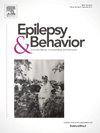Accelerometer-measured physical activity patterns in daily life and their association with factors of sedentary behavior in people with epilepsy
IF 2.3
3区 医学
Q2 BEHAVIORAL SCIENCES
引用次数: 0
Abstract
Objectives
Being physically active is important, but people with epilepsy (PWE) tend to have a sedentary lifestyle. There is limited evidence about physical activity patterns in PWE using objective measures. The aims of this study were: (1) to examine the physical activity patterns of PWE, (2) compare activity patterns between PWE in terms of drug-resistant epilepsy and medically controlled epilepsy with age- and sex-matched healthy controls; and (3) explore the association between physical activity patterns and body function and structure, activity and participation, and quality of life of PWE.
Methods
Seventy-three PWE and 74 healthy controls were enrolled. Physical activity data were collected prospectively over a 7-day period using a SenseWear Arm Band. Body function and structure in PWE were evaluated using the Fatigue Severity Scale, 30-second Chair Stand (30CST), Biodex-Fall Risk, Generalized Anxiety Disorder, Beck Depression Inventory, Pittsburg Sleep Quality Index, and Montreal Cognitive Assessment (MoCA). Activity and participation in PWE were measured using Activities-specific Balance Confidence, Timed Up and Go Test, Six-Minute Walk Test, and Tinetti-Balance and Tinetti-Gait. The quality of life of PWE was evaluated using the Quality of Life in Epilepsy Inventory-31.
Results
PWE took fewer steps per day and were sedentary for more time compared with healthy controls (7826 vs. 10,564 steps, P = 0.01; 534 min/day vs. 463 min/day, P < 0.001), especially PWE with drug-resistant epilepsy. 30CST, MoCA, and Biodex-Fall Risk were associated with sedentary behavior, with Biodex-Fall Risk explaining 7.2 % of the variance.
Conclusions
PWE demonstrated lower physical activity levels compared with healthy individuals, especially those with drug-resistant epilepsy. Our study highlights the need to tailor strategies including postural stability exercises for the enhancement of physical activity levels in PWE.
加速计测量癫痫患者日常生活中的身体活动模式及其与久坐行为因素的关系。
目的:积极参加体育锻炼非常重要,但癫痫患者(PWE)的生活方式往往久坐不动。利用客观测量方法了解癫痫患者体育锻炼模式的证据有限。本研究的目的是(1)研究 PWE 的体力活动模式;(2)比较抗药性癫痫和药物控制癫痫的 PWE 与年龄和性别匹配的健康对照组的活动模式;以及(3)探讨体力活动模式与 PWE 的身体功能和结构、活动和参与以及生活质量之间的关联:方法:共招募了 73 名 PWE 和 74 名健康对照者。方法:招募了 73 名残疾人和 74 名健康对照者,使用 SenseWear Arm Band 收集为期 7 天的体力活动数据。使用疲劳严重程度量表、30 秒椅子站立(30CST)、Biodex-跌倒风险、广泛性焦虑症、贝克抑郁量表、匹兹堡睡眠质量指数和蒙特利尔认知评估(MoCA)对 PWE 的身体功能和结构进行评估。使用特定活动平衡信心、定时起立行走测试、六分钟步行测试、Tinetti-Balance 和 Tinetti-Gait,对残疾人的活动和参与情况进行了测量。使用癫痫患者生活质量量表-31对癫痫患者的生活质量进行了评估:结果:与健康对照组相比,PWE 每天走的步数更少,久坐的时间更长(7826 步 vs. 10564 步,P = 0.01;534 分钟/天 vs. 463 分钟/天,P 结论:与健康对照组相比,PWE 每天走的步数更少,久坐的时间更长(534 分钟/天 vs. 463 分钟/天,P = 0.01):与健康人相比,患者的体力活动水平较低,尤其是耐药性癫痫患者。我们的研究突出表明,有必要量身定制包括姿势稳定性练习在内的策略,以提高 PWE 的体力活动水平。
本文章由计算机程序翻译,如有差异,请以英文原文为准。
求助全文
约1分钟内获得全文
求助全文
来源期刊

Epilepsy & Behavior
医学-行为科学
CiteScore
5.40
自引率
15.40%
发文量
385
审稿时长
43 days
期刊介绍:
Epilepsy & Behavior is the fastest-growing international journal uniquely devoted to the rapid dissemination of the most current information available on the behavioral aspects of seizures and epilepsy.
Epilepsy & Behavior presents original peer-reviewed articles based on laboratory and clinical research. Topics are drawn from a variety of fields, including clinical neurology, neurosurgery, neuropsychiatry, neuropsychology, neurophysiology, neuropharmacology, and neuroimaging.
From September 2012 Epilepsy & Behavior stopped accepting Case Reports for publication in the journal. From this date authors who submit to Epilepsy & Behavior will be offered a transfer or asked to resubmit their Case Reports to its new sister journal, Epilepsy & Behavior Case Reports.
 求助内容:
求助内容: 应助结果提醒方式:
应助结果提醒方式:


